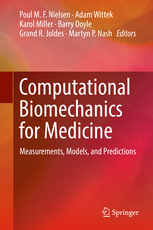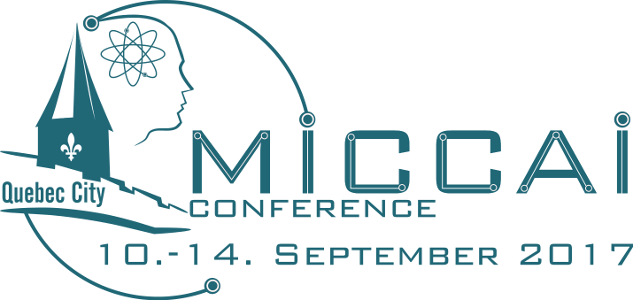Computational Biomechanics for Medicine XII
A MICCAI 2017 Workshop, Quebec City, Canada, 2017 September 14
Home | Organisers | Important
Dates | Scope | Registration
| Submissions
Rationale:
--
 Mathematical modelling and computer simulation have had a profound impact on science and proved tremendously successful in engineering.
One of the greatest challenges for mechanists is to extend the success of computational mechanics beyond traditional engineering,
in particular to medicine and biomedical sciences. The Computational Biomechanics for Medicine workshops provide an opportunity for
researchers to present and exchange ideas on applying their techniques to computer-integrated medicine,
which includes MICCAI topics of Medical Image Computing, Computer-Aided Modeling and Evaluation of Surgical Procedures,
and Imaging, Analysis Methods for Image Guided Therapies, Computational Physiology, and Medical Robotics. For example, continuum mechanics
models provide a rational basis for analysing medical images by constraining the solution to biologically plausible motions and processes.
Biomechanical modelling can also provide clinically important information about the physical status of the underlying biology,
integrating information across molecular, tissue, organ, and organism scales.
Mathematical modelling and computer simulation have had a profound impact on science and proved tremendously successful in engineering.
One of the greatest challenges for mechanists is to extend the success of computational mechanics beyond traditional engineering,
in particular to medicine and biomedical sciences. The Computational Biomechanics for Medicine workshops provide an opportunity for
researchers to present and exchange ideas on applying their techniques to computer-integrated medicine,
which includes MICCAI topics of Medical Image Computing, Computer-Aided Modeling and Evaluation of Surgical Procedures,
and Imaging, Analysis Methods for Image Guided Therapies, Computational Physiology, and Medical Robotics. For example, continuum mechanics
models provide a rational basis for analysing medical images by constraining the solution to biologically plausible motions and processes.
Biomechanical modelling can also provide clinically important information about the physical status of the underlying biology,
integrating information across molecular, tissue, organ, and organism scales.
The main goal of this workshop is to showcase the clinical and scientific utility of computational biomechanics in computer-integrated medicine.
Previous workshops in the series.
Program:
The workshop programme is available for download here.
Invited speakers:
Auckland Bioengineering Institute, University of Auckland, New Zealand
Title: "Image-based biomechanical modelling of heart failure"
Abstract
Effective diagnosis and treatment of cardiovascular disease is hampered by a lack of knowledge of the underlying pathophysiological mechanisms on a patient-specific basis. Biomechanical factors, such as intrinsic myocardial stiffness and tissue stress, are known to have important influences on heart function, but these factors cannot be measured directly. Mathematical modelling provides a rational integrative basis for interpreting the rich variety of physiological data that are available in the laboratory and clinical settings. This seminar will discuss how image-based, individualised biomechanical models of the heart can be used to characterise the relative roles of anatomical, microstructural and functional remodelling in heart failure. Methods and examples from pre-clinical and clinical studies will be presented to demonstrate this approach. Individualised mathematical models of this kind can to help to more specifically stratify the different forms of heart pathology, and thus have the potential to inform patient therapy and management of care.
Prof. Sidney Fels
Director of the Media and Graphics Interdisciplinary Centre (MAGIC), The University of British Columbia, Canada Title: "Making Head and Neck Reconstruction Surgery an Engineering Process"
Abstract
Computer modeling and simulation of the human body is rapidly becoming a critical and central tool in a broad range of disciplines, including engineering, education, entertainment, physiology and medicine. Often, these models underpin the goal of transitioning from an artisanal practice to designing and making to an industrial engineering process. One reason for this approach is that designed and simulated models can be throughly tested used manufactured by machine to high tolerances, potentially removing much of the guess work when addressing complex human body dynamics and variations. The challenge for researchers is how to create patient specific models with enough fidelity for in-silico simulation to accurately predict treatment outcomes. To address these challenges, we are developing technology to create dynamic, parametric, multiscale models of human musculoskeletal anatomy that can later be extended to include organ structures and other subsystems. We are working to provide a range, from low-to-high accuracy, of models, including high-resolution bone surfaces and detailed representations of muscle fibre structure and pennation. A significant component of our approach provides 3D finite element (FEM) muscle models coupled with multibody simulation techniques including contact handling and constraints. Our primary modelling effort is for the oral, pharyngeal and laryngeal (OPAL) complex to predict functional outcomes, such as chewing, swallowing and speaking. I report on our progress with our interdisciplinary team of scientific and clinical investigators, and collaborators and iRSM partners, the advances we have made including: an advanced Functional Reference ANatomy Knowledge (FRANK) template of the head and neck that can be registered structurally and functionally to patient specific data, new techniques for patient specific registration, liquid bolus simulations in the head and neck models, and a new technique for simulating speech from the biomechanics of the airway. Based on our experiences, I will outline a number of grand challenges that require a community of clinical, scientific and engineering researchers to address before we can transition to patient treatment as an engineered solution.

